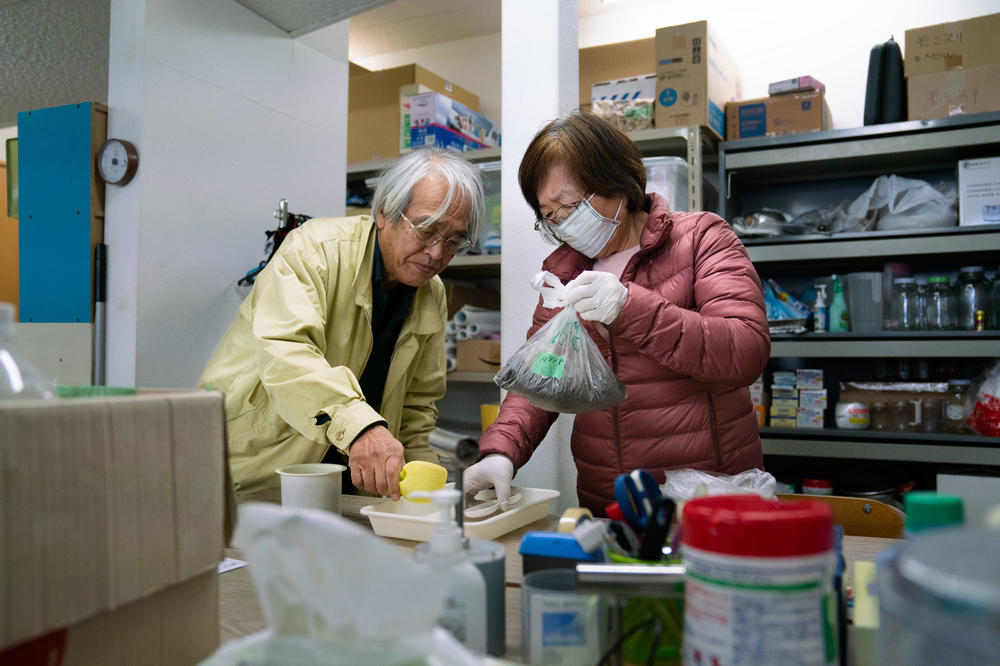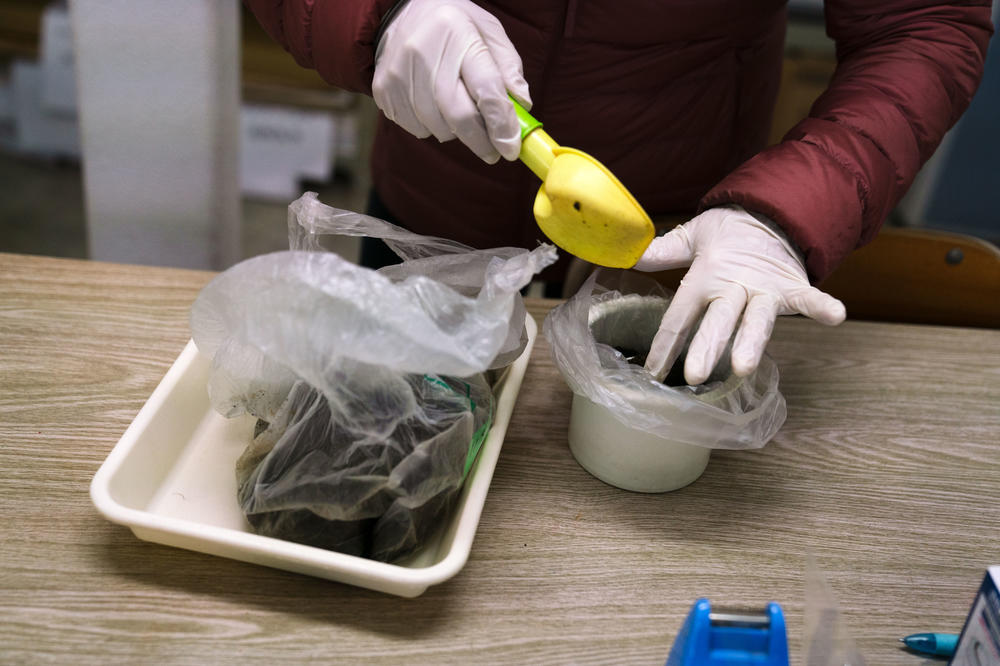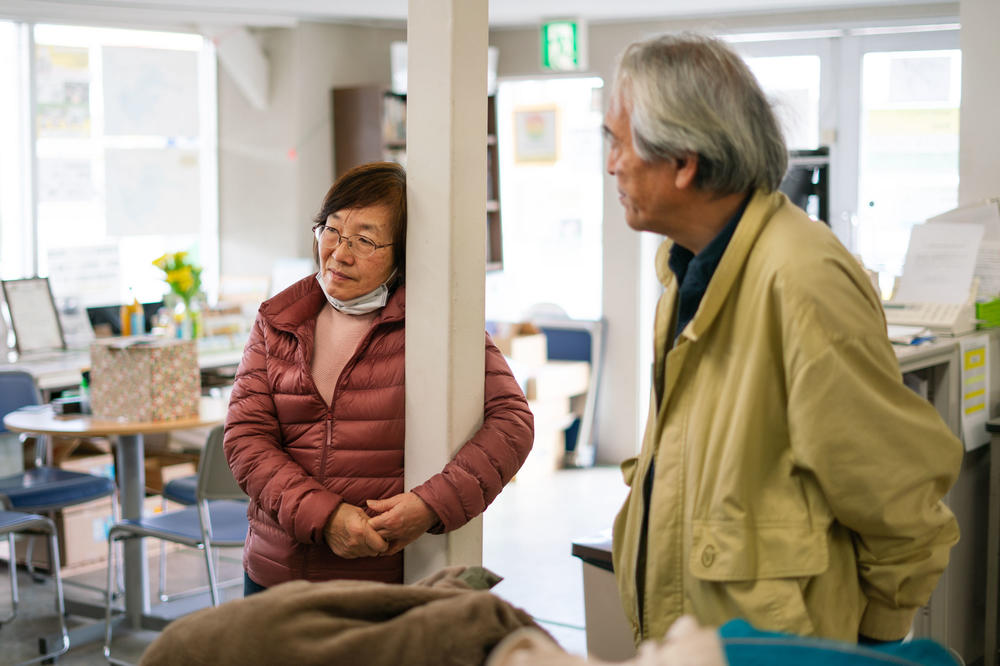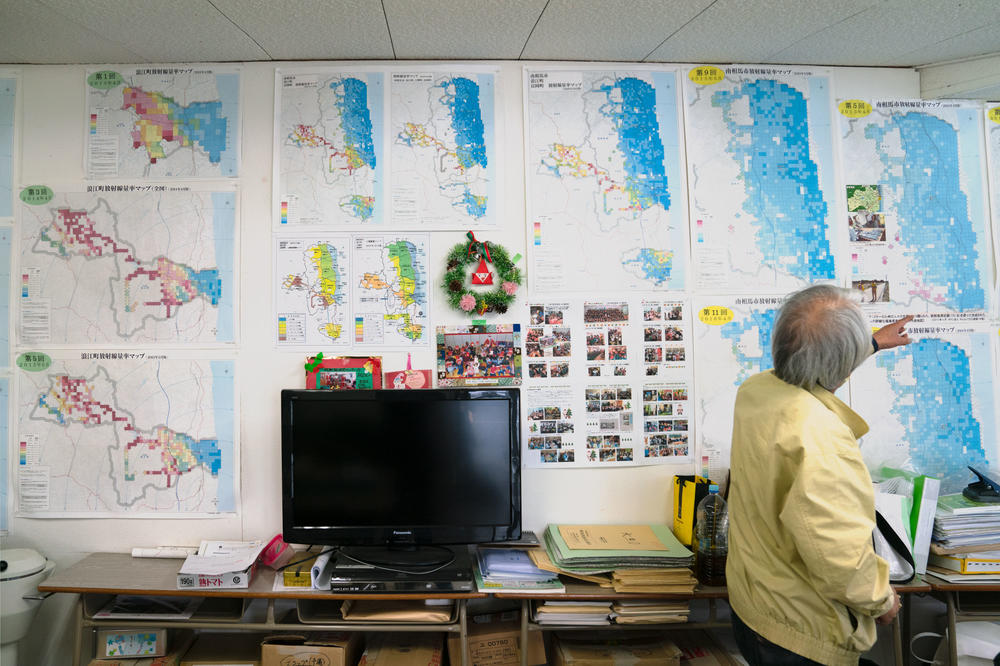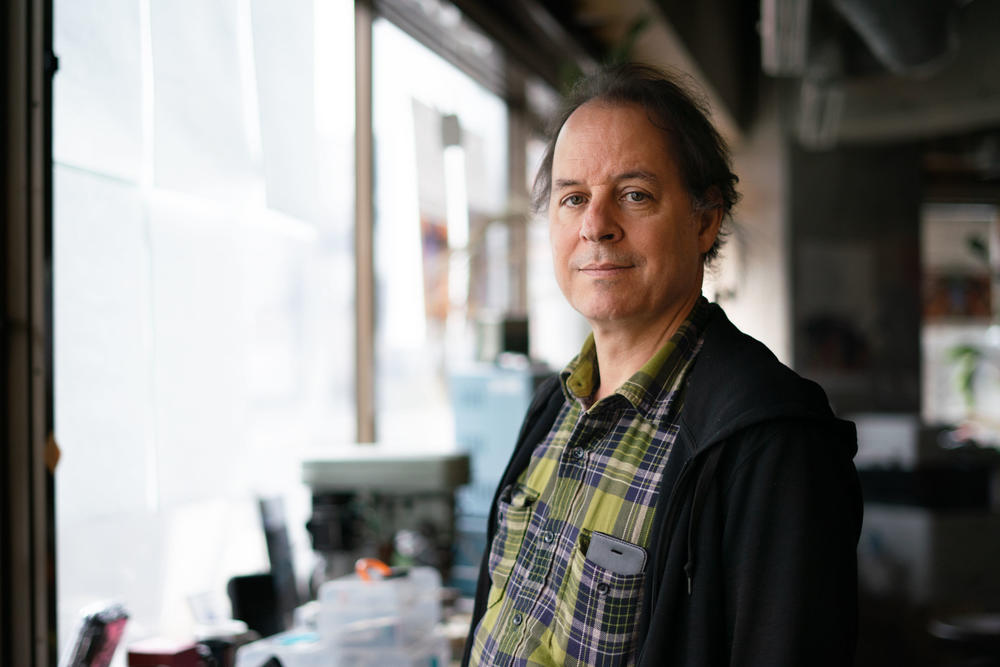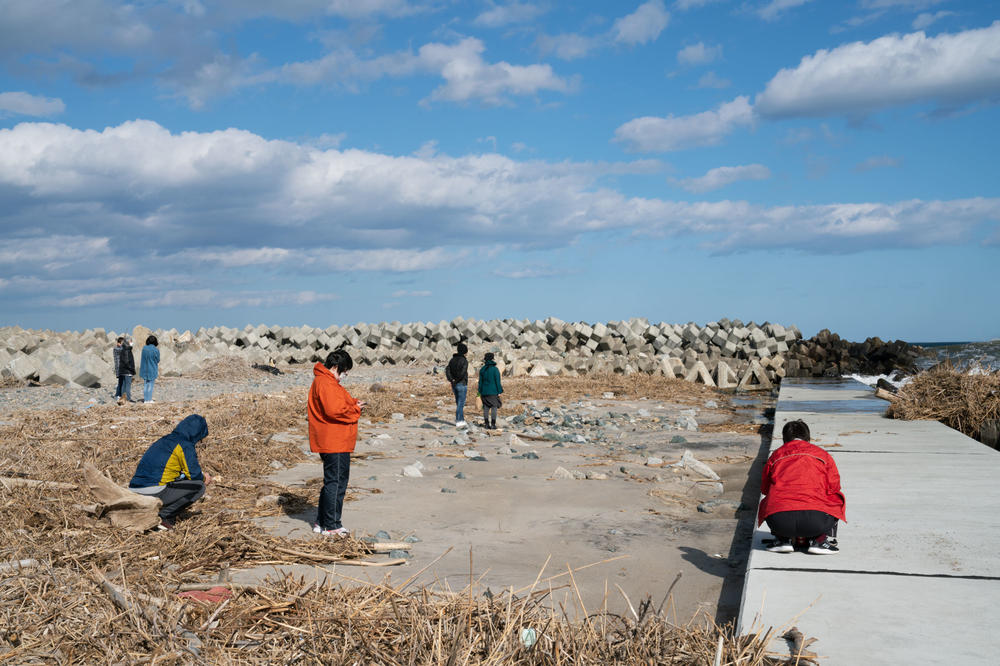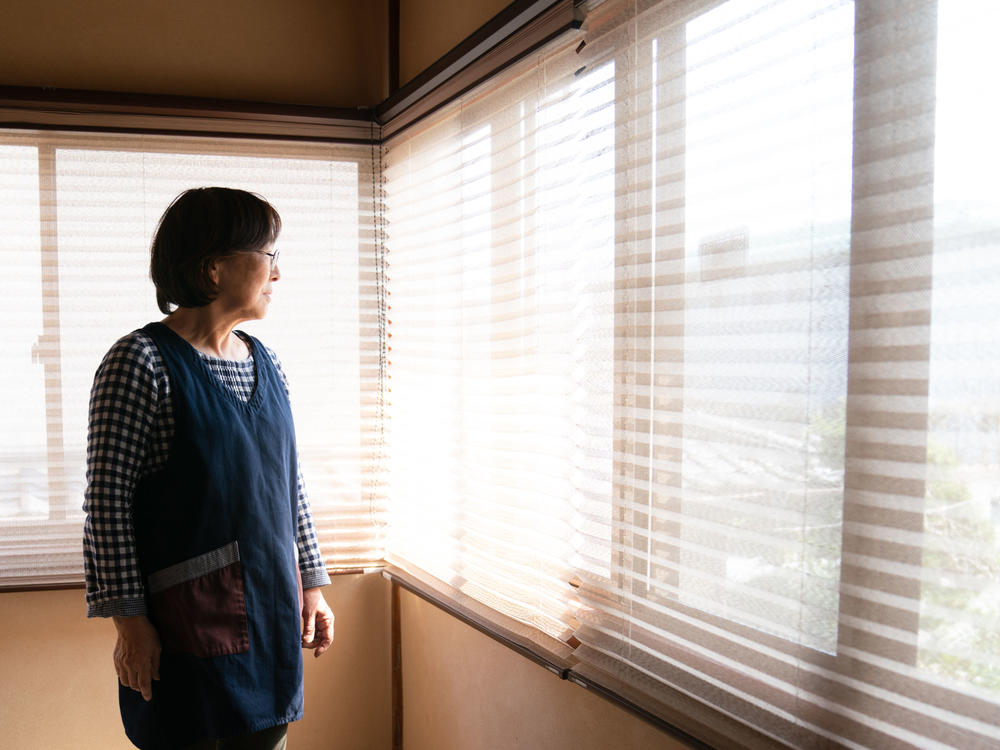Section Branding
Header Content
Fukushima Has Turned These Grandparents Into Avid Radiation Testers
Primary Content
Takenori Kobayashi lugs a garbage bag full of soil across a parking lot to an unmarked office. His wife, Tomoko, holds the door to a tiny work space with lab equipment and computers set up. On the edge of Fukushima's former nuclear exclusion zone, this is the place the couple likes to call their "grandma and grandpa lab."
It started as a makeshift operation in the city of Minamisoma the year after the 2011 nuclear disaster, when people — mostly elderly — returned to the area and were worried about high radiation levels in their food and soil.
"We've given up hope that our children and grandchildren will come back to live here," Tomoko, 67, says. Most young people decided to start lives elsewhere rather than return, not wanting to take the risks with radiation. "But in order for them to come back and visit us," she continues, "we need to know everything is safe. So we test it all."
Citizen science like this flourished in Fukushima after the nuclear disaster in 2011, when a tsunami triggered explosions at the Daiichi Nuclear Power Plant. The wind carried radioactive material for miles, covering whole towns and neighborhoods with dangerous, yet invisible, particles. For weeks after the disaster, information was scarce and trust in the Japanese government plummeted. And now, almost a decade later, wide arrays of residents have taken it upon themselves to collect radiation data — from mothers worried about their kids to surfers monitoring beaches to individuals with Geiger counters in their homes — to help regain a sense of control.
Inside the lab, the Kobayashis pair get to work. One measures out soil into small containers, the other starts labeling — so coordinated and practiced, it's almost like a dance. They put the samples through a donated gamma counter, a big cylindrical machine that measures radioactive particles. Today, they're testing soil from a nearby farm.
A handful of other residents help run the lab, and throughout the years, experts from nearby universities have come to teach them all about the different equipment and radiation science.
"All the grandparents here are radiation professionals now," Takenori, 71, says with a smile.
Before the disaster, he was an accountant, and Tomoko helped run a nearby inn that has been in her family for generations. When the disaster happened, they were forced to evacuate for five years. But when they were allowed to come back home in 2016, they reopened the inn — and learned everything they could about radiation.
"We never thought we'd be doing this. What normal person would expect this?" says Tomoko with a chuckle. "But anyone who faces this kind of situation has to become a scientist to survive."
Takenori points to colorful radiation maps of the area hanging on the wall. The couple made them, along with a team of volunteers, using donated Geiger counters — hand-held devices used to measure radiation — over the past few years as more neighborhoods reopened to the public.
"It is important for us to visualize the invisible," he says. "We needed to see it."
The maps show that Fukushima's radiation levels are decreasing, because of both natural decay of particles and large-scale Japanese government decontamination efforts. But there are still a lot of hot spots — places where radiation is worryingly high. The authorities have tried to ease concerns, testing food in supermarkets and setting up radiation monitors in public parks, outside train stations or flashing along highways, but trust in the government is still extremely low. Many residents say they still feel best collecting information themselves.
One of the original citizen data operations in Fukushima is called Safecast. The nonprofit organization formed in the immediate days after the disaster, when it became clear that accurate radiation information was not available. Safecast started building and distributing radiation monitors in Fukushima, and then putting all the data online for public use.
Now, nearly a decade later, Safecast has hundreds of devices in the area around the Daiichi nuclear power plant, with dozens of local residents helping to take hundreds of readings a day. There's even one hanging in the Kobayashis' inn.
"We found that simply allowing people to take measurements themselves, and have a way to compare it to government data was really important for their peace of mind, for their sense of agency," says Azby Brown, the lead researcher at Safecast.
Part of the reason people want to collect data themselves and compare it is because even after more information became available, it was often contradictory. The United Nations and the International Commission on Radiological Protection have published reports saying that radiation risks in Fukushima are low. Other organizations, like Greenpeace, dispute those findings. The Japanese government insists that the areas being reopened are safe. But many are quick to point out that the government raised the legal limit of radiation exposure in this part of Fukushima prefecture after the disaster — meaning that many of these areas wouldn't necessarily be considered safe in other parts of Japan or the world.
Brown says that giving people the ability to collect and understand their own data can help them ease their anxiety and make decisions based on their personal comfort.
"Some people will look at the data and say, 'Oh my God, I'm leaving,' " Brown says. "Other people will say, 'Oh, you know, it's not as bad as I feared, maybe I'll stay.' And yet others will say, 'Well, it's pretty bad, but now at least I know what I'm facing and I know how hard it's going to be.' "
That last option is ultimately how the Kobayashis felt when they decided to come back after their neighborhood was reopened in 2016. By that point, Tomoko had gotten a Geiger counter. She remembers how empowering it felt to know and understand the reading. It was low enough for the pair, something they both felt comfortable with.
"I was so relieved," she says, "I knew I could come home."
But now, Tomoko says, a new invisible threat has her worried — the coronavirus. She says a lot of the anxiety everyone is feeling now reminds her of how she felt back in 2011. She has stocked up the inn with cleaning supplies, hand sanitizer and cloth face masks. But the travel sector has plummeted during the pandemic.
"Radiation is a bit similar to the virus," she says sitting at the kitchen table of her inn. "It doesn't have any smell, you can't feel it, you can't see it."
Tomoko says she is, of course, aware that the two are very different, but the parallels have been striking to her. She remembers back in March and April, when she saw cities like London and New York looking abandoned and empty on TV. It reminded her of the towns in Fukushima, right after the disaster. It brought back a lot, she says.
"As long as you have a Geiger counter, you can detect radiation," she says. "But with the virus, there is no Geiger counter."
Tomoko says, like many of us, she's eager for science to help find one.
Kat Lonsdorf (@lilkat_bigworld) is NPR's Above the Fray fellow. The fellowship is sponsored by the John Alexander Project, which supports foreign reporting in undercovered parts of the world. Follow the fellowship on Instagram (@thejohnaproject) and Twitter (@thejohnaproject).
Copyright 2020 NPR. To see more, visit https://www.npr.org.
